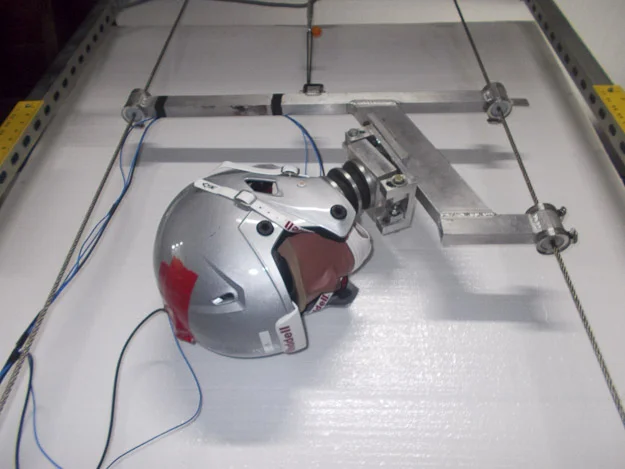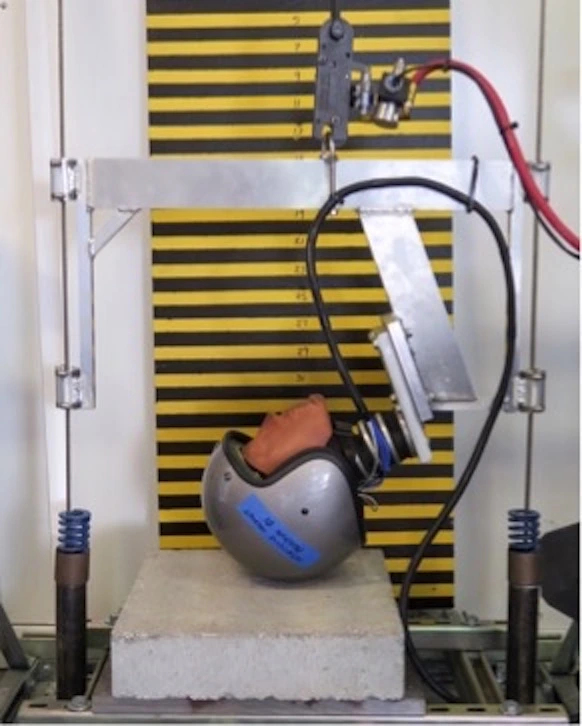The humble helmet dates back nearly 3000 years and though it has been used prolifically in warfare, it is now most commonly used to provide head protection outside the combat arena.
However, although applications might have diversified, it is still fundamentally designed and used to provide the same thing.
So when this most traditional of objects is combined with modern sensor technologies, greater test data resolution and analysis, there is bound to be fresh insight.
And this is the case for many conventional designs where sensors, test and measurement technologies are changing conventional thinking into how something has been designed, to how it should be designed.
It sets the scene and means helmet design is on a collision course for further impact protection, specifically in preventing serious brain injury by giving helmet designers greater clarity in to the mechanical forces at play in any particular scenario.
It was this, along with a lifetime of comprehensive knowledge, which enabled biomechanist Dr John Lloyd, research director of BRAINS, to start up a company dedicated to improving current helmet technology and ultimately improve protection for wearers. He aims to shed new light on helmet design, and improve protection against the fundamental causes of concussion and brain injury.
“There are two key forces at play during a head impact,” said Dr Lloyd, speaking at this year’s National Instruments Week in Austin, Texas. “Firstly there are linear forces, these are the ones that cause visible injuries such as bruising and skull fractures. However, the second is the rotational forces. These are the ones that cause invisible injuries such as concussion and brain injury.
“Current helmet testing technologies measure the linear forces. However, at this time, they do not measure the rotational forces, so consequently we have helmets for many sports that do not test against their ability to provide protection against concussions and brain injury.”
Whether it is for riding a bike, horse riding, skiing or indeed for the soldier in the field, the effect of rotational movement is the same. Yet, it is rarely tested for, and even less frequently measured, to see how effective any helmet is in rotation force protection.
Dr Lloyd modified the standard apparatus used for testing helmets (see the rig on page 28), where a head section is raised 2m on a rig and dropped under gravity before it hits a striking plate with an impact force in the region of 4500N. However, instead of using a standard head form, Dr Lloyd replaced it with a standard automotive crash test dummy head and neck section. This way, when the head impacts the striking plate at the bottom of the test rig it will rotate, and the movement measured.
“We had multiple sensors embedded in the centre of mass of this head form,” explained Lloyd. “So, during the impact we were able to measure the linear acceleration as well as the angular motion of the head.
“My measuring apparatus includes sensors from several manufacturers.. The angular rate sensor, for example, that is used to measure the rotational forces is a highly specialised sensor. And, as a result, has its own data acquisition hardware and software.”
Simplifying synchronisation
Trying to integrate all this data from different sensors was a challenge at best. And to make matters more complicated, the peak linear acceleration and peak angular acceleration actually happen at different points in time.
“So while you can just line up the data,” he said, “there is a lag between them. So we need to measure that lag, which is a critical measurement in the research.”
To resolve the problem, Dr Lloyd uses both the National Instruments LabView graphical software and a CompactDAQ to interface with the sensors and provide the necessary synchronisation between the various sensors.
Dr Lloyd modified his apparatus for testing helmets used by American footballers in the National Football League (NFL), to develop understanding of the how spinal and head injuries are caused and improve the design of the standard helmet.
“The results are pretty alarming in terms of how little protection they provide against concussions and traumatic brain injuries,” he said.
“Based on lessons learned from that study, I have developed a new ‘football’ helmet prototype. This uses a patent pending matrix of non-Newtonian materials and when we tested the prototype helmet, on the same apparatus, the result blew me away. Not only did these materials reduce the linear forces but compared to the standard football helmet they actually reduced the rotational forces that cause concussion and brain injury by an amazing 50%.”
The non-Newtonian materials Lloyd has in mind are inexpensive and produce a helmet that is considerably lighter and even said to be more comfortable for those wearing them.
Dr Lloyd is now expanding the concept of reducing rotation forces in helmets in every application and said it can be applied to almost any helmet design to help reduce concussion and brain injuries from sports to leisure and even back to warfare.
Building a rig and conducting the test
A modification to the US National Operating Committee on Standards for Athletic Equipment (NOCSAE) standard test apparatus was used by Dr John Lloyd, research director of US helmet research start-up, BRAINS.
He developed and validated a new helmet test rig to measure the impact of protective headwear to include measurements of both linear and angular kinematics. This apparatus consists of a twin wire fall test system equipped with a drop arm that incorporates a 50th percentile Hybrid III head and neck assembly from HumaneticsATD crash test dummy, as used in the automotive industry.
The aluminium fly arm runs on Teflon sleeves through parallel braided stainless steel wires, which are attached to mounting points in the building structure and anchored into the concrete foundation. The anvil, onto which the head drop systems impacts, consists of a 350mm x 350mm steel based plate.
Both the standard Riddell Revolution Speed US university football helmet, and the prototype BRAINS helmet that incorporates a non-Newtonian matrix, were dropped from a height of 2m onto a flat steel anvil, in accordance with American Society for Testing and Materials (ASTM) standards. This generated an impact velocity of 6.2 m/s (13.9 mph).
Instrumentation:
A triaxial accelerometer from PCB Piezotronics and three DTS-ARS Pro 18k angular rate sensors (Diversified Technical Systems) were affixed to a tri-axial block installed at the centre of mass in the Hybrid III head form. Data from the accelerometer and angular rate sensors were acquired using National Instruments compactDAQ hardware.
Analysis:
Data from the analogue sensors were acquired at 10,000Hz, per channel, using LabView and then filtered in Matlab using a phaseless 4th order Butterworth filter with a cut off frequency of 1650Hz. Angular acceleration values were derived from the angular velocity data based on a 5-point least squares quartic equation.
Result:
The result of the new helmet design shows significant improvement in rotational acceleration exerted on the head and neck, cutting the overall force by nearly 50%.
Author
Justin Cunningham
– See more at: http://www.eurekamagazine.co.uk/design-engineering-features/technology/why-all-head-protection-is-in-need-of-a-redesign/66493/#sthash.6Tv5duXE.dpuf


